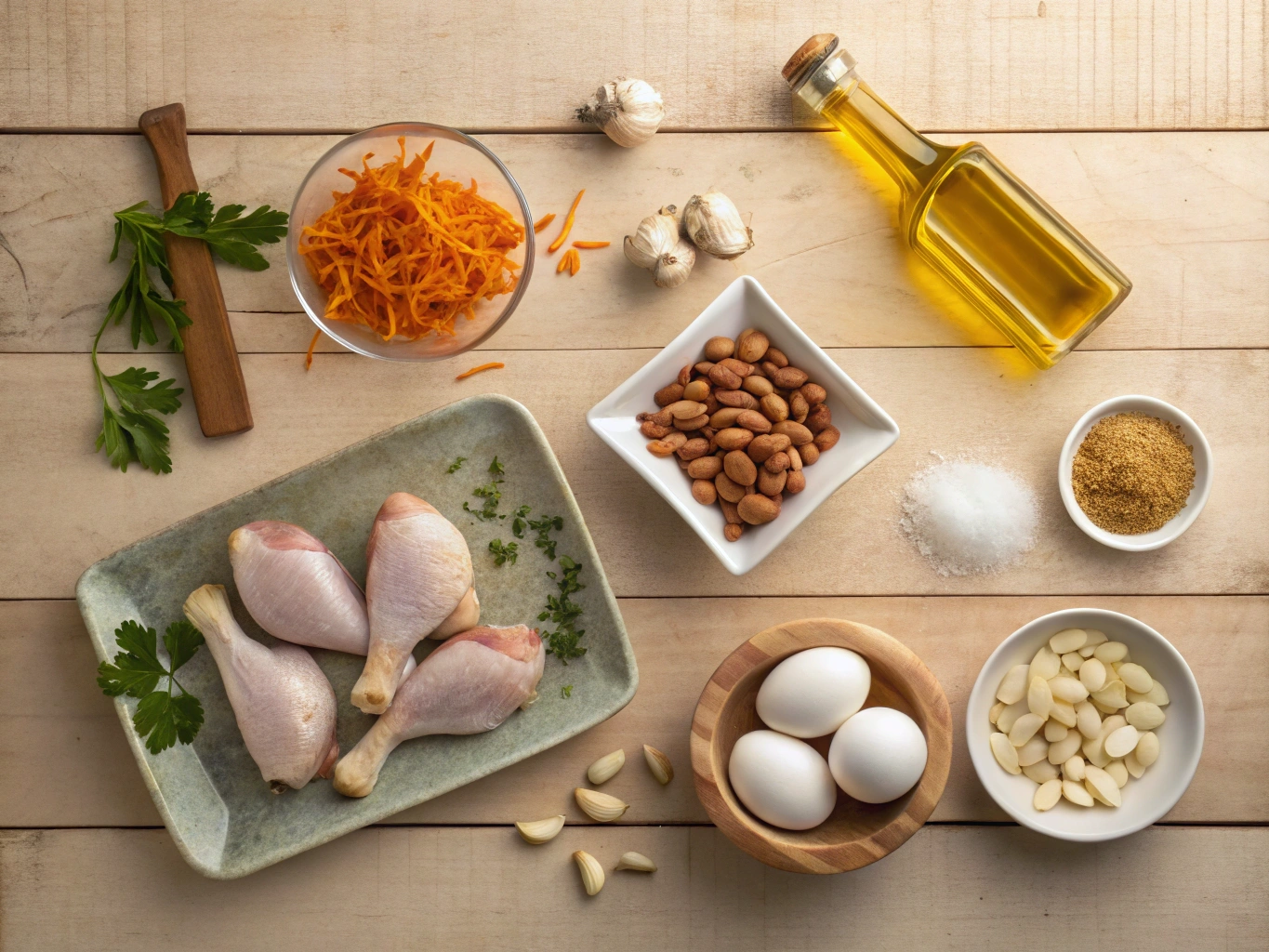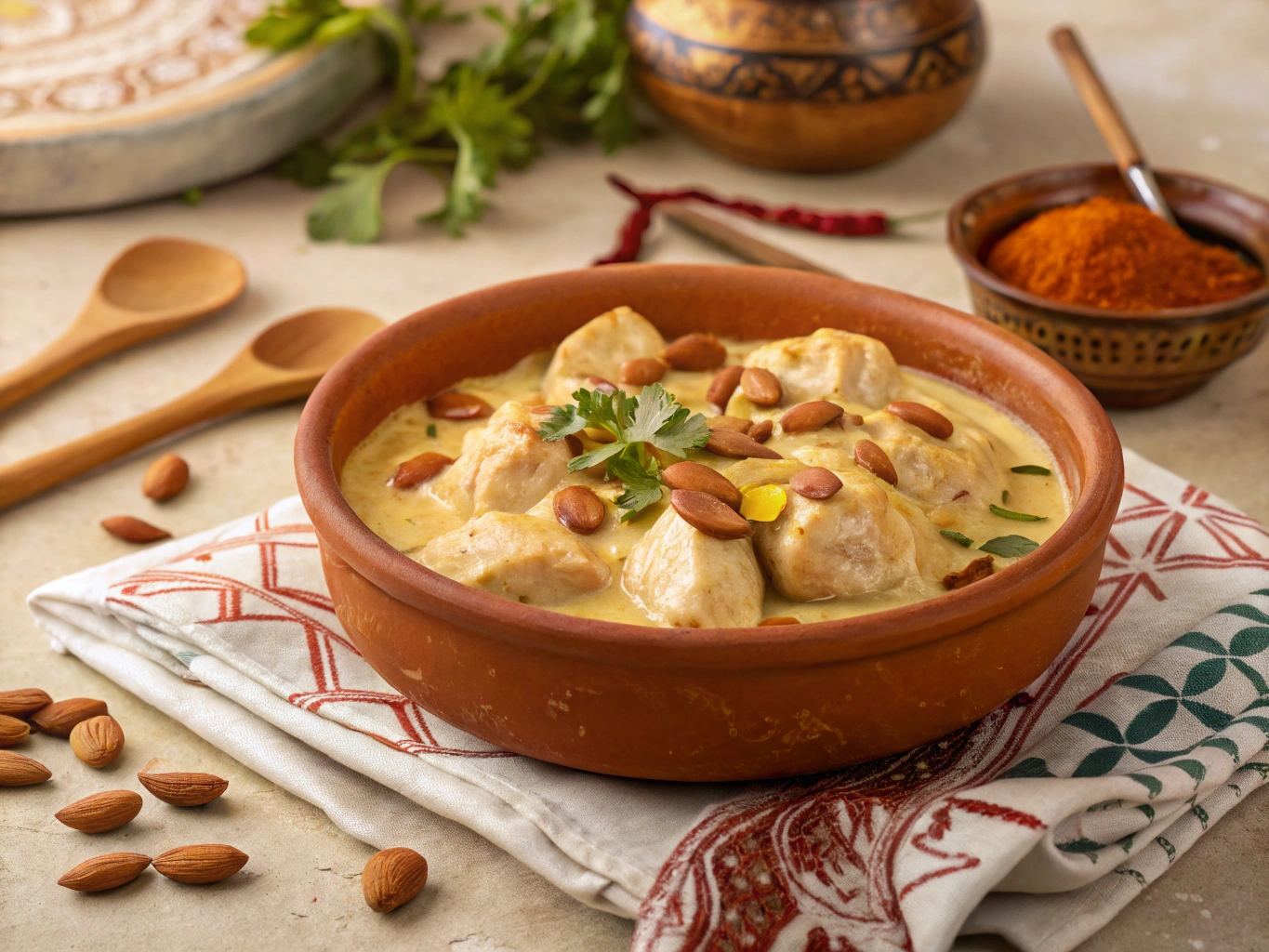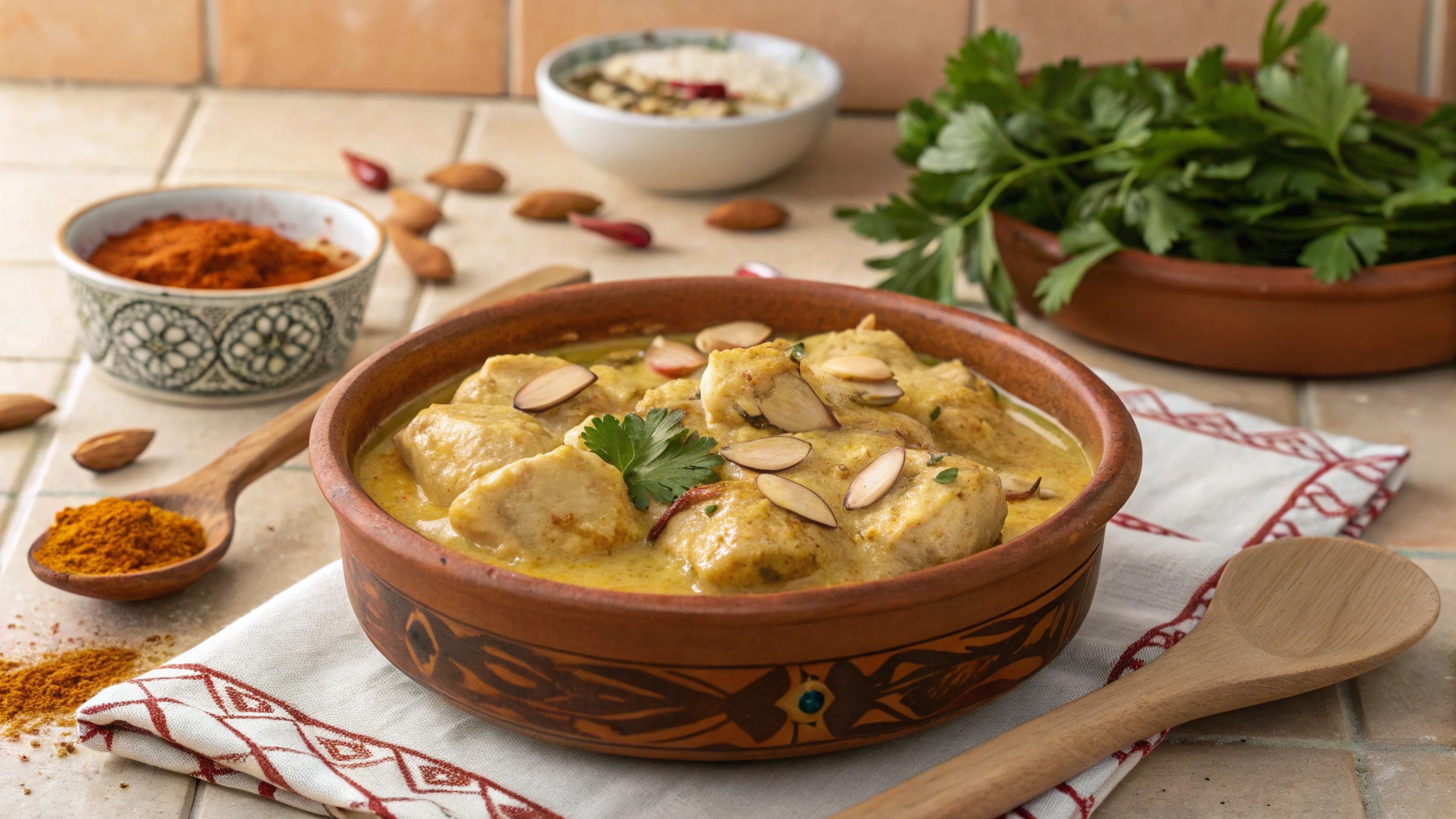Table of Contents
There’s something magical about the moment when saffron hits hot olive oil, releasing its golden hue and distinct aroma into the kitchen air. This sensory experience took me back to a small, family-owned restaurant tucked away in the narrow streets of Toledo, where I first encountered Pollo en Pepitoria. The elderly matriarch emerged from the kitchen, proudly carrying a steaming earthenware dish filled with chicken pieces bathed in a velvety, golden sauce flecked with almonds. One bite, and I understood why this recipe had been cherished for generations.
- Bist Amazon Picks:
You might have sampled countless chicken dishes in your culinary adventures, but Pepitoria stands apart with its unique combination of ingredients and techniques that create a harmony of flavors rarely found in modern cooking. This isn’t just another chicken recipe—it’s a journey through Spanish culinary heritage, offering a taste of history that has graced family tables for centuries.
What is Pollo en Pepitoria? Understanding This Classic Spanish Dish
Pollo en Pepitoria ranks among Spain’s most beloved traditional dishes, boasting a history that stretches back to medieval times. The dish originated in Castilla, central Spain, though variations now exist throughout the country. At its heart, Pepitoria represents the brilliant simplicity of Spanish cuisine—transforming humble ingredients into something extraordinary through thoughtful technique.
Historical records suggest that versions of this dish appeared in cookbooks dating back to the 16th century, though culinary historians believe its roots extend even further. The name “Pepitoria” likely derives from “pepitas” (seeds or nuts), referring to the ground almonds that provide the sauce’s distinctive texture and flavor profile.
Unlike paella or gazpacho, which have gained international fame, Pepitoria remains somewhat of a hidden gem, cherished in Spanish homes but less known abroad. Traditionally served during family gatherings and special occasions, this dish exemplifies how Spanish cooking celebrates community and shared meals.
What makes Pepitoria stand the test of time is its perfect balance of flavors—the richness of almonds, the brightness of saffron, the depth from wine, and the unique thickening technique using hard-boiled egg yolks. These elements combine to create something greater than their parts, a sauce that transforms ordinary chicken into an extraordinary meal.
The Secret Behind Authentic Pepitoria Sauce
The soul of any Pepitoria dish resides in its remarkable sauce. Unlike other chicken preparations that rely on tomatoes or cream, Pepitoria achieves its luxurious texture and complex flavor through a distinctive combination of ground almonds and hard-boiled egg yolks.
Saffron plays an essential role in creating the sauce’s identity. These delicate crimson threads not only impart their characteristic golden color but also contribute an earthy, slightly sweet flavor that cannot be replicated. While expensive, just a small pinch transforms the entire dish, justifying its reputation as “red gold” in Spanish cuisine.
The magic of Pepitoria sauce emerges from the careful balance between several key elements:
- The subtle nuttiness from carefully toasted almonds
- The richness contributed by egg yolks without heaviness
- The aromatic foundation of sofrito (sautéed garlic, onion, and bread)
- The depth from good Spanish white wine
- The distinctive warmth of saffron
Traditional preparation methods involve manually grinding the almonds and egg yolks using a mortar and pestle, which releases their oils differently than modern food processors. While today’s cooks often use technology to save time, purists maintain that the traditional method produces a sauce with superior texture and flavor integration.
Modern adaptations sometimes incorporate cream or additional spices, but authentic Pepitoria relies on the natural thickening power of its core ingredients, creating a sauce that coats each piece of chicken without becoming heavy or cloying.
Essential Ingredients for Perfect Pollo en Pepitoria
The Ingredient List

| Ingredient | Quantity | Notes |
|---|---|---|
| Chicken pieces | 2-3 pounds | Traditional cuts include thighs and drumsticks |
| Almonds | 1/2 cup | Blanched and peeled |
| Garlic | 6 cloves | Freshly minced |
| Onion | 1 large | Finely chopped |
| Bread | 2 slices | Day-old white bread works best |
| White wine | 1 cup | Dry Spanish white preferred |
| Chicken stock | 2 cups | Homemade for best results |
| Saffron threads | 1 pinch | Authentic Spanish saffron recommended |
| Hard-boiled egg yolks | 2 | For thickening and enriching sauce |
| Fresh parsley | 1/4 cup | Chopped for garnish |
| Olive oil | 1/4 cup | Extra virgin Spanish olive oil |
| Salt and pepper | To taste | Sea salt recommended |
Ingredient Substitutions and Special Considerations
While authenticity matters in traditional recipes, adaptability ensures you can create a delicious Pepitoria even when certain ingredients prove challenging to source.
If Spanish saffron exceeds your budget, look for more affordable Iranian varieties, which offer similar color but slightly different flavor notes. In absolute emergencies, a combination of paprika and turmeric provides color, though the distinctive saffron flavor will be missing.
For those requiring gluten-free options, simply omit the bread and increase almonds slightly to maintain proper sauce thickness. The bread primarily serves as a thickening agent rather than a flavor component.
Finding authentic Spanish ingredients has become easier with online specialty stores. However, local Mediterranean markets often carry suitable substitutes. When selecting olive oil, choose one with grassy, peppery notes characteristic of Spanish varieties for the most authentic flavor profile.
Step-by-Step Pepitoria Recipe
Preparation Phase
Begin your Pepitoria journey by properly preparing each component:
- Pat chicken pieces dry with paper towels and season generously with salt and pepper on all sides. This crucial step ensures proper browning and flavor development.
- For the almond mixture, toast almonds in a dry pan until golden and fragrant, being careful not to burn them. Once cooled, grind them finely along with the toasted bread.
- Create your saffron infusion by crushing threads gently between your fingers and soaking in 2 tablespoons of warm (not hot) water for at least 15 minutes. This releases both color and flavor compounds more effectively than adding threads directly to the dish.
Cooking Process
Follow these steps carefully to achieve the authentic Pepitoria flavor profile:
- Heat olive oil in a large, heavy-bottomed Dutch oven over medium-high heat until shimmering but not smoking. Working in batches to avoid crowding, brown chicken pieces on all sides, about 3-4 minutes per side. The goal is golden color, not complete cooking. Transfer browned pieces to a plate.
- Reduce heat to medium and add chopped onions to the same pot with the flavorful chicken-infused oil. Cook until translucent and softened, about 5-7 minutes, scraping up any browned bits from the bottom.
- Add minced garlic and cook for 30-60 seconds until fragrant, being careful not to burn it.
- Pour in white wine and increase heat, allowing it to bubble vigorously while scraping the bottom of the pot to release any remaining browned bits. Reduce wine by approximately half.
- Return chicken pieces to the pot along with any accumulated juices. Add chicken stock and the saffron with its soaking liquid. The liquid should cover about 3/4 of the chicken.
- Bring to a gentle boil, then reduce heat to maintain a low simmer. Cover and cook for 25-30 minutes until chicken is tender but not falling apart.
- While the chicken cooks, prepare your thickening mixture by combining the ground almonds with mashed hard-boiled egg yolks and a few tablespoons of the cooking liquid to create a smooth paste.
A common mistake is rushing the cooking process with higher heat, which prevents the flavors from properly melding. Patient, slow cooking allows the chicken to remain tender while absorbing the sauce’s complex flavors.
Finishing Touches
The final steps transform your simmered chicken into true Pepitoria:
- Remove chicken pieces temporarily and set aside, keeping warm.
- Gradually whisk the almond-egg paste into the simmering sauce until fully incorporated. The sauce should noticeably thicken but remain pourable.
- Return chicken to the sauce, reduce heat to low, and simmer for an additional 5-7 minutes. This final cooking allows the chicken to absorb the enriched sauce flavors while reaching perfect tenderness.
- Taste and adjust seasoning as needed. The sauce should have a complex, rich flavor with no single ingredient dominating.
- For traditional presentation, transfer to a warm serving dish and garnish with freshly chopped parsley, sliced hard-boiled egg whites, and a few toasted almond slivers.
Serving Suggestions for Pollo en Pepitoria

In traditional Spanish homes, Pepitoria typically arrives at the table alongside white rice or boiled potatoes, both perfect for soaking up the precious sauce. Steamed green vegetables or a simple green salad with a light vinaigrette provides welcome freshness against the rich main dish.
For wine pairing, Spanish whites from Rueda or Albariño varieties complement without overwhelming the delicate saffron notes. The slightly acidic profile of these wines cuts through the richness of the sauce while enhancing the dish’s aromatic qualities.
Modern interpretations might serve Pepitoria with crusty artisanal bread, roasted seasonal vegetables, or even atop wide ribbon pasta for a Spanish-Italian fusion approach. However you choose to serve it, ensure there’s something to capture every last drop of the exceptional sauce.
Make-Ahead and Storage Tips for Your Pepitoria
Like many traditional stews and braises, Pepitoria actually improves with time as flavors meld and deepen. You can prepare the entire dish up to two days ahead, storing it in the refrigerator after cooling completely. When reheating, do so gently over low heat, adding a splash of chicken stock if the sauce has thickened too much during storage.
For longer storage, Pepitoria freezes remarkably well for up to three months. Thaw overnight in the refrigerator before reheating. The sauce might initially appear slightly separated, but gentle warming while stirring will restore its silky consistency.
Many Spanish cooks prepare Pepitoria deliberately in advance, knowing that overnight refrigeration allows the flavors to marry more completely, creating an even more harmonious dish when served the next day.
Nutritional Benefits of Pollo en Pepitoria
Beyond its remarkable flavor, Pepitoria offers notable nutritional advantages. The chicken provides high-quality protein essential for muscle maintenance and satiety, while the almond-based sauce delivers heart-healthy monounsaturated fats and vitamin E, a powerful antioxidant.
Saffron, beyond its culinary contributions, contains compounds with potential mood-enhancing and antioxidant properties. Recent research suggests it may support cognitive function and emotional well-being.
The olive oil foundation delivers additional monounsaturated fats and anti-inflammatory compounds, aligning with the Mediterranean diet patterns consistently associated with longevity and reduced disease risk.
Even the egg yolks, once unfairly maligned, contribute important nutrients including choline for brain health and lutein for eye protection.
Variations on Classic Pepitoria
Travel through Spain and you’ll discover regional adaptations reflecting local ingredients and preferences:
In Andalusia, cooks often incorporate a touch of sherry vinegar for brightness and might finish the dish with a sprinkle of smoked paprika.
Catalonian versions sometimes include pine nuts alongside or replacing some of the almonds for a different flavor dimension.
In northern regions, you might find herbs like bay leaf or thyme added to the simmering liquid.
Modern interpretations have emerged as well, including versions using rabbit instead of chicken, vegetarian adaptations with mushrooms, and simplified preparations using modern appliances like pressure cookers or slow cookers.
For special celebrations, some Spanish families create a more luxurious version by adding a small amount of brandy to the sauce and garnishing with sautéed ham.
Frequently Asked Questions About Pollo en Pepitoria
What makes an authentic Pepitoria recipe different from other Spanish chicken dishes?
Pepitoria distinguishes itself through its unique almond-egg yolk thickening method, creating a sauce unlike any other in Spanish cuisine. While dishes like Chicken with Garlic (Pollo al Ajillo) or Chicken in Tomato Sauce (Pollo con Tomate) rely on reduction or tomato-based thickening, Pepitoria achieves its silky texture through the emulsifying properties of ground almonds and egg yolks. The mandatory inclusion of saffron further sets it apart, lending distinctive color and flavor impossible to replicate with other spices.
Can I make Pollo en Pepitoria in advance for a dinner party?
Not only can you prepare Pepitoria ahead of time, but you absolutely should! The dish actually improves after resting for 24-48 hours in the refrigerator, as this allows the flavors to mature and meld more completely. Simply reheat gently before serving, adding a small amount of chicken stock if needed to adjust consistency. This make-ahead quality makes Pepitoria perfect for entertaining, allowing you to focus on guests rather than last-minute cooking.
What’s the history behind the traditional Pepitoria recipe?
Pepitoria’s roots stretch back to medieval Spain, with documentation in cookbooks from the 16th century onward. The technique of thickening with ground nuts and egg yolks shows clear Moorish influence from the centuries of Islamic presence in the Iberian Peninsula. The dish exemplifies the cultural blending in Spanish cuisine, combining European poultry preparations with Middle Eastern and North African flavor profiles and techniques. Some food historians believe Pepitoria evolved from earlier court recipes, eventually becoming adopted across social classes throughout Spain.
What are the best sides to serve with Pollo en Pepitoria?
Traditional accompaniments include plain white rice, boiled potatoes, or good-quality crusty bread—all designed to soak up the prized sauce. For a complete Spanish meal, consider serving simple green vegetables dressed with olive oil and lemon, or a fresh salad with orange segments and olives to provide contrast to the rich main dish. While not traditional, roasted seasonal vegetables also pair beautifully with the sauce. Whatever sides you choose, ensure they complement rather than compete with Pepitoria’s complex flavor profile.
Can I use chicken breast instead of dark meat in my Pepitoria recipe?
While traditional Pepitoria calls for bone-in, skin-on dark meat (thighs and drumsticks), you can adapt the recipe using chicken breasts. However, several adjustments become necessary: reduce the initial browning time to prevent drying, shorten the overall cooking time by about 10 minutes, and consider using bone-in, skin-on breasts for better flavor and moisture retention. Remember that breast meat won’t contribute the same richness to the sauce, so you might want to enhance your chicken stock or add a dash more olive oil to compensate.
Is there a way to make Pepitoria without saffron?
While authentic Pepitoria requires saffron for its characteristic flavor and color, budget constraints might necessitate alternatives. A combination of sweet paprika and turmeric (about 1/4 teaspoon of each) provides similar visual appeal but cannot replicate saffron’s distinctive taste profile. Some cooks substitute saffron with safflower (“Mexican saffron”), which offers color but minimal flavor. In truth, nothing perfectly replaces real saffron, which is why even Spanish home cooks often reserve their precious supply specifically for signature dishes like Pepitoria where its presence defines the recipe.
Embracing Spanish Culinary Tradition
As your fork breaks through the tender chicken and collects the velvety golden sauce, you’re participating in a culinary tradition spanning centuries. Each spoonful of Pepitoria connects you to countless Spanish families who have gathered around tables to share this beloved dish through generations.
The beauty of preparing traditional recipes like Pepitoria extends beyond the remarkable flavors—it offers a moment to slow down and appreciate the thoughtful techniques our culinary ancestors developed. In our world of instant meals and shortcut cooking, dedicating time to properly toast almonds, infuse saffron, and gradually build layers of flavor represents a small act of resistance against the rushed pace of modern life.
When you serve Pepitoria to friends and family, you’re not just offering nourishment, but sharing cultural heritage and creating space for the kind of meaningful connection that happens when people gather around exceptional food. This is perhaps why such recipes endure—they satisfy something deeper than hunger alone.
Make this Pepitoria recipe your own. Perhaps you’ll add a personal twist that your family will come to recognize as “your” version, becoming part of your own culinary legacy. Traditional cooking isn’t about rigid rules but about keeping time-honored techniques alive while allowing them to evolve organically with each new generation of cooks.
Have you tried making Pollo en Pepitoria before? What Spanish dishes do you enjoy cooking at home? Share your experiences in the comments below, or tag us in your Pepitoria creations on social media—we’d love to see your interpretation of this classic Spanish treasure!

